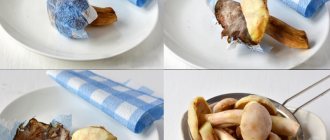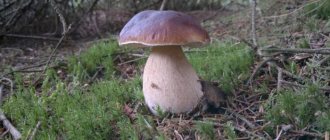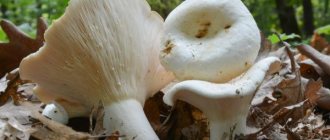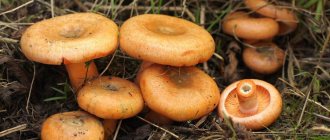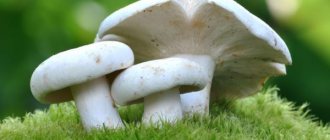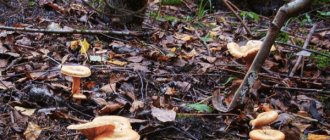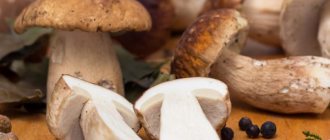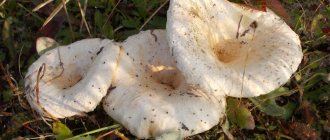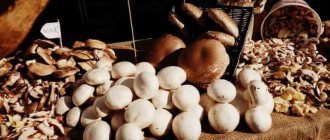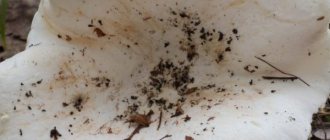Mushrooms
0
2200
Article rating
Kira Stoletova
Milk mushrooms are one of the most popular mushrooms among lovers of “quiet hunting”. Historically, in some countries they have been classified as inedible or conditionally edible. Although processing milk mushrooms is a troublesome task, mushroom pickers respect them for their high nutritional value and excellent taste, especially when pickled or salted.
Proper processing of milk mushrooms
What types of milk mushrooms are there?
In order not to confuse the milk mushroom with its doubles and not throw away the edible mushroom, it is important to know what they are.
The most famous ones are white. They are also called real, pepper or wet. They have a very pronounced bitter taste, which is why they must be soaked before cooking and cleaning, as described above. Black milk mushrooms, as the name suggests, have dark caps. In order not to spoil the dish, it is recommended to cook and salt them separately from white ones due to the milky juice and sticky substance with which they are coated. They should be washed especially thoroughly before cleaning.
Not everyone collects dry milk mushrooms. Despite the fact that they are also edible, their appearance repels even experienced mushroom pickers. At the same time, this mushroom is not bitter, being, in fact, one of the types of russula, and not a real milk mushroom.
Features of collection
Depending on the region, milk mushrooms should be collected from August until the last days of September.
When collecting milk mushrooms, you need to adhere to the same rules as when going for other mushrooms:
- The sooner you go into the forest, the greater the likelihood of becoming the first pickers.
- Leaving early in the summer will help you collect mushrooms that the sun will not have time to heat. In this case, they will be stored longer than those heated by the sun.
- You need to choose a route so that the sun does not hit your eyes, but most of the time it is located and, accordingly, shines from behind or from the side.
Not all varieties are safe, so it is important to familiarize yourself with which ones you can eat and which ones are best left in the forest.
- white milk mushrooms - they are white or slightly bluish. When soaked in water, they may change and become grayish or greenish in color;
- black milk mushrooms - their caps have a brownish-greenish color.
In their natural habitat, edible mushrooms are found in various forests, mainly birch and pine-birch. They tend to grow in large families next to trees with which they form mycorrhizae.
You can recognize them by their flat-convex cap with a dense structure. The skin is slimy, the color of young mushrooms is milky, and that of older mushrooms is yellowish.
The plates under the caps are frequent and wide. With age, they acquire a rich yellow tint and become covered with brown spots. It is not recommended to eat such specimens.
Clean milk mushrooms correctly!
Each stage of mushroom preparation is important. And cleaning is one of the main points. Many recipes don't even mention that mushrooms need to be cleaned. But starting to cook without pre-processing is at least reckless. Mushrooms are heavy food, and the largest amount of harmful substances always accumulates in the upper covers. Mushrooms themselves absorb everything harmful from the environment, which is why properly processing them before pickling or frying is a matter of life and health for you and your family.
So, when the mushrooms have already been soaked for several days, all the spoiled areas have been cut off, we begin cleaning. This is convenient to do with a stiff brush. To avoid searching for anything in stores, use any unnecessary toothbrush. Also a good, but less convenient option is a dish sponge with a hard surface. The mushrooms are cleaned to an even white color. Sometimes you can find information that black and white milk mushrooms are cleaned the same way. In principle, this is true, but you also need to additionally remove mucus from the black ones, which does not improve the taste of the finished dish.
Dry milk mushrooms are not soaked for days because they do not taste bitter. They can be cleaned almost immediately. The only secret is that mushrooms soaked in boiling water are much easier to clean. After soaking, the hat becomes soft and it is much more convenient to clean it of dirt by simply placing it under running water. Dry milk mushrooms do not need to be kept in brine for a long time, since they do not secrete bitter milky juice, like white and black ones.
A little about basic cleaning
After 1-2 days, rinse the milk mushrooms thoroughly and place them in clean water at room temperature. Peel each white mushroom separately. Clean the hat with a toothbrush (stubborn dirt) or a dishwashing sponge if the dirt can be easily washed off. Wash in circular motions without damaging the surfaces. Using a knife, scrape off the spore-bearing layer from the inside of the cap, since grains of earth and sand usually accumulate there.
If the milk mushroom is large in size, it is recommended to cut it into several parts for ease of cleaning from contamination. The mushrooms need to be peeled until white and the stems should be trimmed.
The cleaned milk mushrooms need to be rinsed in the water with which they are filled and transferred to a clean pan or bucket of water. Already peeled milk mushrooms should stand for another day in salted water. And only the next day, after washing under running water, should you start salting them.
The most proper soaking is done with running water. In the city this method is not very convenient. But in villages and villages, you can use soaking milk mushrooms under running water. To do this, take a bag or package made of material that allows water to pass through and fill it with mushrooms, then attach it to the crossbar and place it between the banks of the stream. If this happens in a river, then tie the rope holding the neck of the bag to a stake driven into the ground. In this case, the object itself must be in water. The mushrooms are left in this position for several days, after which they are removed, cleaned and salted.
Lovers of salty and crispy milk mushrooms should be careful when salting, as if handled incorrectly there is a risk of losing their taste and color.
Hot salting method
Mushrooms are most often salted hot, and milk mushrooms are no exception.
After preliminary preparation, when they are soaked, dried and properly cleaned, they are placed in an enamel container and boiled for about half an hour. Then the mushrooms are taken out of the water and laid out on a wide dish. It is better not to pour out the broth. If the mushrooms have been previously prepared and cleaned properly, then the broth is edible. It adds incredible flavor to any sauce or soup. In a separate bowl, prepare the brine in the proportion of 1 liter of water: 2 tbsp. l. salt, black and allspice, other seasonings.
Milk mushrooms are boiled in boiling brine for about half an hour. Add horseradish and garlic there.
Afterwards they are put under oppression. They cover the top with a plate, and some kind of pressure is placed on it. The easiest way is to put a jar of water. The mushrooms will begin to release water, which will eventually cover them. If little water has been released, add the brine in which they were boiled.
The mushrooms remain under pressure for about a month, and then they are put into jars. You can cover with cabbage leaves and place under nylon covers.
How to pickle white milk mushrooms with cabbage leaves?
The presence of greenery makes mushrooms more tasty and aromatic. Therefore, many housewives often use this recipe. In order for the preparation of white milk mushrooms to go quickly and without hassle, you should stock up on all the necessary components in advance. To do this, your kitchen should have the following components:
- Eight cabbage leaves.
- Five kilograms of white milk mushrooms.
- Ten sprigs of dill with umbrellas.
- 200 grams of salt.
- Head of garlic.
- Horseradish root.
- Twenty currant and cherry leaves each.
Pre-prepared mushrooms are blanched. Wash the greens in cool running water. As for cabbage leaves, each of them is divided into small fragments.
Place milk mushrooms in a three-liter clean jar, sprinkle with salt, some herbs and garlic passed through a press. The layers are alternated until the container is full. Then the dish is covered with a lid, a weight is placed on top and sent to a cool place until fully cooked.
Cold salting method
It takes much longer than the hot version, but it is somewhat simpler.
The milk mushrooms are cleaned of dirt, sticks, twigs, washed under running water and placed to soak. After the required time has passed, the mushrooms are cleaned using a stiff brush or sponge with a hard cleaning surface.
After this they are cut into pieces. The ideal option for cold pickling is slicing. This is easy to do if you cut the mushroom into triangles, starting from the cap.
Sliced mushrooms are poured with water and placed under pressure. The main thing is to optimally select the weight of the oppression so as not to simply crush the mushrooms.
The mushrooms should be soaked for about a week. To prevent water from stagnating and spoiling, it must be changed daily.
When a week has passed, the water needs to be drained and the mushrooms inspected. If necessary, all damaged areas are trimmed.
The mushrooms are then washed again and covered with salt. Iodized salt, despite all its usefulness, is better not to use. Mushrooms may turn black and lose their attractive appearance, although their taste will not be affected.
Mix again and put under heavy pressure. Stir occasionally, as the milk mushrooms will release juice during the pickling process.
After three days, mix the mushrooms again. Mushrooms are tightly packed into sterilized jars and filled with brine. There is no need to seal the jars, but you can simply close them with plastic lids and put them in the refrigerator.
Collection and preparation for use
Milk mushrooms are white mushrooms with a cap diameter of 5-20 cm. Mushroom pickers are not always able to notice them from under the leaves and dry grass. These mushrooms are collected using a stick. They use it to stir up the forest floor in search of a trophy. Young specimens of small and medium size are considered the most valuable.
Irina Selyutina (Biologist):
Raw or white milk mushrooms are not common, but they always form large families. When searching for these mushrooms, it is important to find at least one and then you will find others. In search of representatives of this species, mushroom pickers inspect clearings in birch groves, as well as the northern slopes of hills and slopes. Fruiting bodies grow from year to year in the same place. The good thing is that worms do not really like milk mushrooms for their milky juice. Compared to the cap, the leg of this species is simply miniature, so it can be quite difficult to see the cap. When arming yourself with a stick to search, you need to take into account the fact that with it you can accidentally damage the cap or, even worse, the mycelium. In the second case, within a few years you will have to forget about the treasured place.
To make your task easier in the future, you begin to process and clean milk mushrooms during the collection period, i.e. already in the forest. To do this, before cleaning, the cut mushroom is inspected for damage by worms. Small ones are carefully trimmed, and for large ones, the entire fungus is removed.
Hidden insects and slugs are removed under the fringe. They also need to be cleaned of debris adhering to the cap and soil at the bottom of the stem.
Milk mushrooms are rarely eaten fried or boiled. This is all due to the bitterness that the milky juice imparts to the finished dish: do not forget that white milk mushrooms are classified as conditionally edible mushrooms. When pickled, mushrooms are valued for their wonderful taste: meatiness, juiciness and unique aroma.
Cleaning milk mushrooms collected in the forest begins with culling those that are not suitable for consumption, that are loose and old. Instances are divided by type: different types will be salted or pickled separately. Then they are washed under running water and soaked for a day. The container with mushrooms is placed in a cool room, the water is changed several times. During this time, all the milky juice comes out.
After the soaking procedure, the milk mushrooms begin to be cleaned. To do this, use a brush with stiff bristles (or a toothbrush), a sponge with a rough surface, or a sharp knife. The mushrooms are carefully scraped until white, cutting off in the process areas that have been damaged by prolonged exposure to water. Then rinse again under running water.
Express method for salting milk mushrooms
Don’t want to wait a couple of months for the mushrooms to be salted?
Here is a very quick recipe for pickling mushrooms. Wash the mushrooms, clean them with a stiff brush and put them under pressure, changing the water daily. After three days, take them out, cut them in half and put them in a bucket, sprinkling each layer with salt. Do not use iodized salt. No matter how useful it is, it turns the mushrooms black. Place the mushrooms under pressure for three days, stirring them occasionally. Afterwards, they can be placed in pre-sterilized jars and placed in the refrigerator under a nylon lid.
Is a water change necessary?
Before the main cleaning, milk mushrooms must be soaked in water, otherwise they will become bitter later.
Before the main cleaning, milk mushrooms must be soaked, otherwise they will taste bitter. Therefore, during the day it is necessary to change the water at least 5 times, and preferably every 3-4 hours.
If you increase the time between water changes, the milk mushrooms may turn sour. The water should always be cold.
Before draining the water from the container, you need to rinse the milk mushrooms in a circular motion.
Then, holding the lid, drain the water so that the mushrooms do not fall out. Pour clean water and cover with a lid with a weight.
Filled milk mushrooms should stand in a dark and cool place.
Do not use warm or hot water, as the mushrooms will become soft and unsuitable for further cleaning. If you start cleaning such a mushroom, it will break and crumble.
Frying dry milk mushrooms
There is nothing tastier than fried dry milk mushrooms. Before frying, it is better to boil them so that they become softer. But before cooking they need to be cleaned. Despite the fact that dry milk mushrooms are not covered with mucus, they also absorb all the most harmful things from the environment, accumulating it all in the skin. Mushrooms are cleaned as follows. Take an old toothbrush or just a hard sponge and use it to remove the top skin. Then boil the mushrooms and start frying. It is better to add finely chopped onion, so the dish will acquire an additional flavor. Salt, pepper, serve with herbs.
What can you do with salted milk mushrooms and a recipe for leg caviar
What else can you do with salted milk mushrooms? It turns out that you can fry them with onions and potatoes and even make a delicious French appetizer - julienne.
Many housewives pickle only the caps of the fruiting bodies and remove the stems. In this regard, the question arises: what can be done with the legs of milk mushrooms? For example, you can cook delicious caviar.
To do this, you need to grind the boiled legs in a meat grinder. And then, adding chopped vegetables and spices to taste, simmer the mixture over low heat for 30 minutes.
How to pickle milk mushrooms at home - 5+ recipes [2018]
Salted milk mushrooms are a purely Slavic snack. "Why?" - you ask. Because this mushroom is considered conditionally edible and is prepared only in our area.
It is completely safe for health, contains a lot of protein and nutrients, but has a bitter taste.
It is for this reason that milk mushrooms are not suitable for frying or soups, but are ideal for pickling.
Especially if the final product is slightly crispy.
And in order to get rid of the unpleasant aftertaste and delight yourself with a delicious everyday and holiday snack for the whole winter, just soak the mushrooms and start pickling.
This article contains the best recipes for salting milk mushrooms at home and properly processing mushrooms before cooking.
Preparing mushrooms for pickling
And the most important thing in cooking mushrooms is collecting them.
In order not to cause irreparable harm to your health, remember that you need to collect milk mushrooms, as well as any other mushrooms, in environmentally friendly places and under no circumstances eat them raw.
It is these foods that absorb the greatest amount of poisons first, so during the mushroom season, go away from highways and factories.
Also adhere to the following rules:
- Before pickling, carefully sort the mushrooms and discard any wormy or damaged ones. Rinse the rest thoroughly.
- If stains cannot be removed under running water, brush them off with a toothbrush.
- To remove all harmful substances, immerse it in a bowl of cold water for two hours.
- Next, for pickling, cut into 3-4 pieces. You can also salt only the caps and use the legs to prepare mushroom caviar.
- Soak the mushrooms for three days, changing the water three times a day and rinsing each mushroom.
For soaking, choose a deep dish, place a plate on top and put pressure on it. Mushrooms should be in liquid and not floating on the surface. - During the soaking process, the milk mushrooms will lose all their bitter juice and noticeably decrease in volume.
- Use ceramic, wooden or glass dishes. You should not salt milk mushrooms in metal or clay containers. The metal oxidizes, and the clay absorbs all the aroma.
Before cooking, mushrooms need to be washed and soaked.
Method No. 1. How to salt milk mushrooms at home in a cold way
This is the easiest recipe for pickling mushrooms, since it eliminates the need to prepare brine.
You will need:
- 1 kg white milk mushrooms
- 40 g salt
- Bunch of dill
- 2 bay leaves
- 5 cloves garlic
- Horseradish root
- Ground black pepper to taste
Cold cooking method
Step-by-step preparation:
- At the first stage, soak the mushrooms for three minutes, as indicated above, to remove all the bitterness from them.
- Next, in a deep bowl, chop the dry bay leaf, garlic and horseradish. We also send finely chopped dill there, add salt and ground black pepper to taste.
- Take a jar for pickling.
Place a little mixture on the bottom, pieces of mushrooms, and the pickling mixture again and alternate layers until the ingredients are gone. - We compact it with a wooden masher, close it with a plastic lid and put the jar in the refrigerator.
- We salt the mushrooms for 30-40 days, after which they can be tasted.
- If the appetizer tastes too salty, the mushrooms can be washed with water.
Method No. 2. How to salt milk mushrooms at home using a hot method
This method of salting is considered the safest, since when boiled, all the natural bitterness and unpleasant odor will be removed from the milk mushrooms, and additional heat treatment will protect your health.
Method No. 3. How to salt milk mushrooms at home - Altai recipe
In Altai, during the mushroom season, milk mushrooms are salted in wooden barrels of several kilograms - and this is the main difference between this method.
This type of mushroom usually grows in whole families - if you manage to find one such family, it means there are several more hiding nearby.
Method No. 4. How to salt milk mushrooms at home deliciously - the simplest step-by-step recipe
This pickling method is suitable for those who simply adore mushrooms, but do not consider themselves a fan of spices. It contains only 2 components.
Method number 6. Cooking milk mushrooms in cabbage leaves
For a snack, we have prepared for you the most unusual way of pickling milk mushrooms.
How to process milk mushrooms before salting: video tips on how mushrooms are processed
Encyclopedia "Mushroom-Info"ProcessingMushrooms for the winterHow to properly process milk mushrooms after harvesting
Before processing milk mushrooms before salting or preparing any other culinary dish, we suggest reading simple and very useful advice from famous chefs. They talk about how to process milk mushrooms at home using available tools.
Knowledge of how to properly process milk mushrooms is very useful, since if housewives make mistakes, they risk losing all the prepared preserves due to its spoilage.
It is important to understand that before processing milk mushrooms after being collected in the forest, you need to simply disassemble them, arrange them into piles according to size and remove the debris. This is the most important rule. Because it is absolutely forbidden to pickle mushrooms of different sizes together.
Some of them will not be salted, while others will be very over-salted. So, read about how to properly process milk mushrooms - all the tips are presented in an accessible form on this page.
How to process dry milk mushrooms
The value of milk mushrooms lies in their flavor and aromatic substances, which determines the widespread use of mushrooms in the preparation of various dishes, as well as sauces and soups.
It is customary to sort dried mushrooms, wash them in 3-4 waters and soak them in cold water. Salted and pickled milk mushrooms are also sorted and, if necessary, cut.
Salted milk mushrooms must be kept in brine before processing, otherwise their taste and appearance will deteriorate.
Before processing dry milk mushrooms, you need to soak them to swell.
How to process black milk mushrooms for pickling
The purpose of cooking mushrooms is to reduce or completely eliminate the bitter taste or toxicity. But it reduces the nutritional value of mushrooms and weakens their taste and aroma. Therefore, mushrooms should be used whenever possible without prior heat treatment.
Before processing milk mushrooms for pickling, they are boiled for 15–30 minutes in plenty of water. The broth is poured out. There are two ways: bring the water to a boil (add 1/2 tablespoon of salt to 1 liter of water), put the mushrooms in boiling water, leave for 5-15 minutes and transfer to cold water.
Or the mushrooms are dipped in cold salted water and quickly brought to a boil. After boiling, remove the dishes from the heat and allow the mushrooms to cool in the same water or fill them with clean water. After the water is drained, the mushrooms are transferred to a cloth bag or on a sieve to drain the water.
Before processing black milk mushrooms, remember that you should not dry them by squeezing them firmly, as many valuable substances are removed.
This is necessary to maintain integrity and elasticity during cold pickling and fermentation. The washed mushrooms are thrown into a sieve and poured over with boiling water, dipped in boiling water for a few minutes or kept over hot steam. After this, the mushrooms become more elastic and do not break.
How to process white milk mushroom before drying
Before processing white milk mushrooms before drying, you need to remove all forest debris and sort the raw materials by size. Mushrooms are not washed before drying. The rule common to all drying methods is that the mushrooms are dried for 2–3 hours at a temperature of +40–50 °C to evaporate the main amount of moisture.
Then the mushrooms are dried at a temperature of +70–80 °C. After drying for several hours in the shade, the mushrooms are dried in the sun. You cannot dry them in ovens, as they easily burn. Mushrooms should be dry to the touch, slightly bendable and break easily.
The top of the cap is yellowish or brown in different shades: dark brown in white milk mushrooms and from yellow-brown to black in black ones. Store dried mushrooms in dry, well-ventilated areas, on racks in packaged form or hanging in bundles.
It is unacceptable to store dried mushrooms together with salted and pickled mushrooms, with fragrant herbs and wet foods. If the mushrooms are damp or moldy, they must be sorted and dried, removing the spoiled ones.
Collection and processing of milk mushrooms
Collection and processing of milk mushrooms should be carried out on the same day, since fresh mushrooms cannot be stored for long periods of time due to the high percentage of water they contain. A few days after picking, the mushrooms wither, lose their freshness and juiciness and become unfit for consumption.
Therefore, mushrooms should be used for consumption only a few hours after collection after suitable heat treatment or processing into stable food products, i.e. canning. Processing milk mushrooms begins with choosing a suitable method for subsequent culinary processing.
At home, mushrooms are prepared for future use by drying, pickling, salting and canning in hermetically sealed glass jars. When drying mushrooms, up to 76% of the water present in them is removed. The remaining moisture is not enough for the development of microorganisms, which leads to their death.
When preparing natural canned food, the microflora is killed by the high temperature at which the canned food is sterilized. When pickling, the vital activity of microorganisms is suppressed by high temperatures during cooking, and then by the action of acetic acid and table salt.
When salting mushrooms, fermentation occurs, during which sugars turn into lactic acid. The latter, together with table salt, is a preservative.
Safe handling of dry milk mushrooms
At home, when preparing mushrooms for future use (salting, pickling, pickling, etc.), you must strictly follow the rule - do not seal the mushrooms hermetically.
Safe processing of dried mushrooms is a long soaking in several waters in order to remove all possible toxins and poisons.
There must be access to air in dishes with mushrooms, otherwise they can cause a serious disease - botulism, which, according to medical statistics, leads to death in 60% of cases. It has been established that the disease is caused by toxins secreted by the bacillus (bacillus) - botulinus.
This microbe develops and multiplies in an environment where there is no air at all. The main source of infection is soil.
Therefore, mushrooms in contact with it, and often immersed in it, are one of the most potentially dangerous carriers of spores and botulism bacilli.
Moreover, the causative agent of the disease can be in soil particles, on the surface of mushroom caps, below, between the plates, and on the stalks, especially in their lower part.
Therefore, by cutting mushrooms in the forest, and not uprooting them, the picker thus takes the first protective measure against the occurrence of the disease, since he leaves in place the lower, most soil-contaminated part of the stem (and at the same time protects the mycelium - mycelium) from destruction.
Processing black milk mushrooms before salting
When processing black milk mushrooms before salting, you should very carefully remove soil, adhering leaves, blades of grass, various debris, etc. Mushrooms are washed (except for those intended for drying), changing the water several times in order to clear them of soil as best as possible.
Despite this, it is possible that botulinus spores and bacilli may get into mushrooms prepared for future use; those who like to especially remember to store this product in hermetically sealed containers, in jars sealed (rolled up) with metal lids or glass ones with “locks”.
No home treatment of milk mushrooms before salting or sterilization prevents the release of botulinus poison, since its spores die at a temperature not lower than 120–125 °C, which can only be achieved in autoclaves at industrial food plants, although the toxin itself is destroyed by boiling.
Meanwhile, at home, along with salting, pickling, fermentation, mushrooms are often canned, fried, stewed in their own juice, and also boiled in lightly salted or acidified (citric acid, vinegar) water, after which the jars are rolled up.
In such cases, it is necessary, at least before seaming, to sterilize the jars in boiling salted water (400 g of salt per 1 liter of water), since its boiling point is above 100 °C.
Immediately before use, such canned food must be boiled for at least 30 minutes, counting from the moment of boiling.
To do this, put the mushrooms along with the broth from the jars into a saucepan, pour in a little cold water (to boil) and put on the fire.
After boiling for 25 minutes (not earlier), the mushrooms and broth can be tasted. During this time, botulinum toxin, if present, is already destroyed. If there is a lack of salt, add salt to the mushrooms; if there is too much, add water.
If necessary, acidify the broth and add spices as desired - bay leaf, dill, allspice. After boiling for another 5 minutes, the mushrooms are cooled and served. They can be stored in the refrigerator for no more than 2 days.
This method of processing canned mushrooms is approved by microbiologists and sanitary doctors.
Nevertheless, homemade hermetically sealed mushrooms are undesirable. It may be acceptable for pickled mushrooms, and in the only case: when the acidity of the marinade is not lower than 1.6%. In such an environment, the development of spores and reproduction of botulism rods does not occur, and, consequently, the formation of dangerous botulinum toxin.
Salted mushrooms should be stored only in conditions of free access to air. Do not cover jars with pickled and salted mushrooms with metal lids - this can lead to the development of the botulinus microbe. It is enough to cover the jar with two sheets of paper - plain and waxed, tie it tightly and put it in a cool place.
First aid for botulism
Botulism leads to general poisoning of the body, the disease develops very quickly. Within a few hours after eating food containing the toxin, weakness, dizziness, and loss of visual acuity occur. A person suffers from pain in the stomach area and feels ill. The victim must be urgently taken to the hospital.
And as first aid, you should undertake the most vigorous lavage of the stomach and intestines with a 5% solution of baking soda, use radical laxatives and enemas.
To avoid this serious disease, you must adhere to one more rule: do not buy salted or pickled mushrooms on the market from private traders.
You should eat only home-cooked mushrooms when you are absolutely sure that they are all edible, carefully processed, salted or pickled in compliance with preventive measures against botulism, stored in proper conditions and with systematic care (removing mold, digesting marinades if necessary, etc.) . P.).
Watch how to process milk mushrooms in the video, which provides advice from experienced chefs on how to cook mushrooms.
article:
Source: https://grib-info.ru/pererabotka/griby-na-zimu/kak-pravilno-obrabotat-griby-gruzdi-posle-sbora.html
Features of mushrooms and beneficial properties
White milk mushrooms (real ones) are considered the most delicious for pickles. It has a tubular, outstretched cap, the middle of which becomes depressed with age. The diameter of the cap can reach 20 cm. The flesh of the fruit is white. The milky juice at the cut site acquires a yellow tint.
Black milk mushroom (nigella) has a dark green or yellow-brown round cap. The surface of the cap is moist with the edges curved inward. Sometimes you can see concentric circles on the cap. The pulp is white. Salted mushrooms take on a wine color.
Fleshy milk mushrooms are rich in carbohydrates, proteins and minerals, which are easily absorbed by the human body. It is recommended to include boiled mushrooms in various diets, as they contain a large amount of protein. Breast milk also has other beneficial substances:
- vitamins B and D;
- carotene;
- ascorbic acid;
- phosphorus;
- calcium;
- magnesium.
Consumption of these fruits has a beneficial effect on the nervous system, increases immunity and the performance of hematopoietic organs. In folk medicine, pepper milk is often used to treat kidney and urolithiasis.
Milk mushrooms for the winter: secrets and features of preparing the product
If you ask any mushroom picker how to properly process and preserve milk mushrooms for the winter, you will certainly receive a complete dossier on such mushrooms and a lot of other useful information.
The fact is that they have always been in honor of the Russian people since the time of Ancient Rus'. They were used to cook aromatic soups, make savory pickles, and tender pies. Many traditions of that time have survived to this day.
In this article you can take a closer look at these delicious mushrooms and how to process them.
What you need to know about milk mushrooms?
While residents of Western countries avoid the loose caps of milk mushrooms and consider them poisonous, in Russian forests mushroom pickers organize a real hunt for them. There are quite a few types of such forest gifts:
- White milk mushrooms - these products are also called raw due to the fact that their cap is covered with a mucous membrane. They grow mainly in forest plantations and are distinguished by a bright cap the color of baked milk. Mushroom pickers prefer to salt white milk mushrooms, because in this form they have an exquisite aroma and spicy taste. Salted milk mushrooms can be recognized by their bluish tint.
- Black milk mushrooms - these mushrooms are considered the most resistant, since they can be found in the forests even before frost. Popularly, the mushrooms are called nigella mushrooms because of their characteristic green-black color. When salted, they can be stored for up to three years, fully retaining their excellent taste.
- Aspen milk mushrooms - the easiest way to find such mushrooms is in sedge forests and plantings. They are considered quite rare and have an exclusive taste. In appearance, such products are distinguished by snow-white caps with pink spots.
- Blue milk mushrooms - not every mushroom picker will decide to prepare these strange colorful products. After touching, they acquire a bluish color, and bright purple juice flows from the cut stem. While some consider them poisonous, others salt blue mushrooms year after year.
- Yellow milk mushrooms - you can see such products in coniferous and fir forests, hiding under last year's foliage. If you are not sure of the quality of the mushroom, it is better to leave it under a tree. The fact is that they are very similar to poisonous varieties.
If you think that people have preserved their love for milk mushrooms since ancient times only because of their impeccable taste, you should know that they also have healing properties. They were always present at the feasts of rich nobles.
The valuable microelements contained in such mushrooms will help cure diabetes, tuberculosis and even emphysema.
Milk mushrooms can be a real boon for vegetarians, as they contain important and essential amino acids.
Features of pre-treatment of mushrooms
First of all, you need to remember that milk mushrooms contain toxic substances that need to be disposed of before further preparation. Since these products are considered conditionally edible, they must be carefully processed before salting or frying.
When you bring wild mushrooms home, under no circumstances should they be tightly closed and sent in this form to a cold place. This will significantly increase the risk of botulism, since in an environment without oxygen, intensive growth of pathogenic bacteria begins.
That is why you need to thoroughly wash and clean each mushroom.
How to process milk mushrooms after harvesting? You need to strictly follow the recommendations of experienced mushroom pickers to get rid of toxic substances and maintain the excellent taste of the product. In fact, there is nothing difficult about this if you do everything in order:
- Sort mushrooms by type. If you collected not only milk mushrooms, but also other forest inhabitants, you need to sort them by type, since some varieties are generally better not kept in one place. You can also separate small mushrooms from large units, which will make cleaning them much easier and faster.
- Free the mushrooms from large debris. Milk mushrooms grow near mighty stumps next to young trees under old leaves and moss; ants and other insects settle next to them. Getting rid of this junk manually can not only be difficult, but also painfully time-consuming. If you want to learn how to quickly clean milk mushrooms, a little trick will help you with this: get a small brush with soft bristles. It will help you quickly and effortlessly remove pine needles, bugs and pieces of leaves.
- Finish cleaning with a knife. This sharp object will complete the stage of cleaning the milk mushrooms from dirt and debris, since with its help you can trim and scrape off all excess. Remove wormy spots, spoiled particles and stem.
Only after all these procedures can you start washing.
How to wash milk mushrooms correctly?
Place the cleaned mushrooms in a wide bowl under running water, rinse the food several times, then cover with cold water and leave for several hours.
It should be easy to wash the milk mushrooms from the remaining dirt, as they will become soggy and will not adhere firmly to the surface. It is recommended to soak milk mushrooms for three days.
During this time, the products must be completely free of toxic substances, bitterness and any other harmful components.
Now you know how to wash milk mushrooms and make them suitable for further cooking. Then you can leave the mushrooms whole or cut them into smaller pieces.
Pre-cleaning
Milk mushrooms freshly brought from the forest must be cleared of soil, leaves and grass.
Milk mushrooms freshly brought from the forest usually contain a lot of foliage, earth and grass. First, the white milk mushrooms are sorted out and the rotten (wormy) ones, as well as those with a loose structure affected by slugs and insects, are removed. It is necessary, without sparing, to cut off the eaten and broken parts of the milk mushroom.
Remove large debris and grass by hand. Then use a knife to scrape off the stuck leaves and blades of grass.
Before placing mushrooms in a container, you must first rinse them under running water to remove major contaminants. Then the mushrooms are placed in a basin or bucket and filled with cold water.
You need to let them stand for 2-3 hours so that the dirt leaves the surface of the mushroom, then remove it with a brush. Then fill it with water again. There should be no more than half the container, since the mushrooms rise to the top. To prevent them from floating up, cover the container with a lid and place a weight in the form of a jar of water or a small saucepan.
If there are insects left in the mushrooms, they will die. In this state, the mushrooms should last a day or two.
To prevent milk mushrooms from losing their color, you can add a pinch of citric acid or 1 tablespoon of salt per 6 liters of water to the water.
Return to contents
